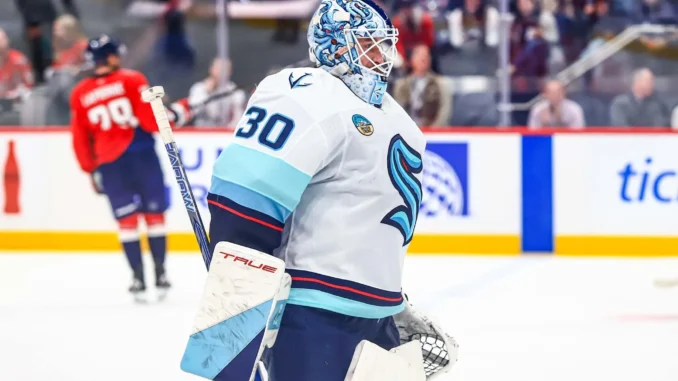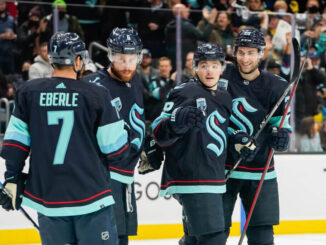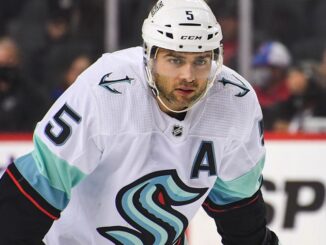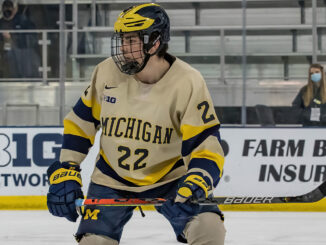
As every level-headed sports fan knows, it’s never too early to draw sweeping conclusions about a team’s fate less than a month into a new season. So what’s stopping us from doing the same with the Seattle Kraken, less than a month into the franchise’s fifth year of existence?
The Kraken are currently in the mix for a playoff spot after starting the season with four wins and 10 points in their first eight games, sitting second in the Pacific Division. Those results are an improvement on their start to last season, when they were 5-8-1 after 14 games and had already dug an early hole for themselves in the postseason chase. Driving their early success is their strong work on the defensive side of the puck, which has historically been their calling card until last season. Let’s dive in.
Lambert’s Defensive System Paying Early Dividends
Under Dan Bylsma’s watch in his only campaign behind the Kraken bench, Seattle went from one of the league’s best shot and chance suppression squads to one of the worst. Take a look at their leaguewide rankings in several defensive categories during five-on-five play compared to 2024-25. A reminder that it is still very early into new head coach Lane Lambert’s tenure, but the 60-year-old bench boss has managed to treat some of the wounds suffered under Bylsma’s stewardship.
| Season | Shots Against | Scoring Chances Against | High-Danger Chances Against | Expected Goals Against |
| 2024-25 | 24th | 24th | 24th | 24th |
| 2025-26 | 22nd | 12th | 18th | 13th |
Lambert himself explained his long-term goals and on-ice strategy during preseason, stating that “protecting the middle of the ice has always been critical for [him]” and that doing so put the goaltenders in the best position to succeed. That in-zone strategy has been paired with a more aggressive forecheck that doesn’t leave Seattle waiting on its heels in its defensive zone. Less than a month into the season, Lambert’s principles appear to be paying early dividends.
The Kraken also finished 25th in actual goals allowed per 60 minutes last season, with the team’s goaltending failing to drag them up as it had in years past. Despite seeing his raw save percentage (SV%) at five-on-five drop from .933 to .916 from 2023-24 to 2024-25, Daccord still saved an impressive 15 goals above expected (GSAx) compared to 18 the year prior. Instead, Philipp Grubauer allowed nearly 19 goals more than expected, pushing the Kraken into negative territory and leaving them unable to paper over their shaky defensive structure.
Daccord’s uncharacteristically average start to the season has overshadowed the defensive gains, but that should be corrected before too long, and he even shut out the Winnipeg Jets on Thursday night. For what it’s worth, Grubauer is actually positive in this regard for the first time since joining the Kraken, sitting at a plus-0.17 in two appearances.
The Kraken’s two best defensive pairings for chance suppression have been Ryan Lindgren alongside Jamie Oleksiak, Lindgren alongside Cale Fleury, and Josh Mahura alongside Jamie Oleksiak. Those partnerships rank 23rd, 45th, and 49th, respectively, in high-danger chances allowed per 60 minutes among the 154 duos to have played (a tiny sample size of) 20 minutes together at five-on-five. They haven’t faced the most challenging opponent matchup, but they have prevented opposing teams from reaching the more dangerous areas of the ice.
One other area of improvement has been the Kraken’s penalty kill. Yes, they’ve allowed six goals on 21 shorthanded opportunities for a woeful 71.4% kill-rate, but the team ranks eighth by expected goals allowed per-60 and first by high-danger chances allowed per-60 while down a man. It’s a stark contrast to last season, where the Kraken penalty kill ranked 21st while also languishing in the bottom five by every shorthanded defensive metric. The process was poor, and Daccord’s efforts in goal partially masked the units’ deficiencies.
Lambert’s teams have historically trotted out a very effective penalty kill, so it’s reassuring to see that underlying numbers have followed him to Seattle, even if the surface-level results have yet to follow.
Kraken Offense Yet to Emerge
Despite the defensive numbers improving, the offensive side of the puck remains a clear issue. The Kraken are one of the league’s worst teams at generating any respectable level of volume or quality of shots and scoring chances, which has contributed to their share of said shots and chances plummeting to near the bottom of the league.
This concerning trend is linked to a well-documented lack of stars up front and reliable puck movement on the blue line outside of Vince Dunn and Brandon Montour, despite some of their young players showing signs of taking the next step offensively.
Forward Jaden Schwartz currently leads the team in scoring with four goals and eight points in eight games. That is respectable output in isolation, but pales in comparison to the rest of the league, especially when it comes to other teams’ scoring leaders. Forty-seven players have scored four or more goals this season, while 76 players have tallied seven or more points. Schwartz is the only Kraken member to belong to either group.
In Lambert’s defense, both Ryker Evans and Kaapo Kakko have yet to play this season due to injury, while McCann, Mason Marchment, and Montour – three of their better offensive weapons – have already joined them on the sidelines. However, Montour’s absence is not hockey-related.
This parade to the infirmary has pushed everyone higher in the lineup, including rookie forwards like Berkly Catton, Jani Nyman, and Ryan Winterton. These promotions are stretching the charges thin beyond the top six up front. Seattle’s ability to move the puck effectively through all three zones and away from its crease is being tested, and the lack of reliable outlets is becoming readily apparent.
Kraken Holding Strong Amidst Injury Crisis
The coaching staff shouldn’t be judged on how the offense performs until the aforementioned key figures return, but they should be held accountable for the defense. Those results are more often determined by the coaches’ structure and by the players’ effort and awareness. For now, the goaltenders are receiving better protection than last season, which has allowed the Kraken to tread water in the admittedly shallow Pacific Division. How long that barrier holds without significant reinforcements remains to be seen.
Data courtesy of Evolving Hockey, Natural Stat Trick, and the NHL.




